Leyden Jars
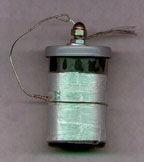
This is a jar made from a film canister. The original picture and how
to build it are on Lenny
R's web page. There's also a quick and dirty (but very effective) static
generator there. |
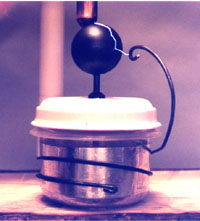
This is one of my jars. It's made from a polyethylene food container.
The ball on top has a coating (graphite) that allows a spark to travel
along its surface (as well as jumping the gap). |

Here's a fine jar made by PV
Scientific Instrument company. They make reproductions
of many classical laboratory instruments. |
A Leyden jar is a device that early experimenters used
to help build and store electric energy. It was also referred to
as a "condenser" because many people thought of electricity as fluid or
matter that could be condensed. Nowadays someone familiar with electrical
terminology would call it a capacitor.
Basically, the Leyden jar is a cylindrical container made
of a dielectric (that's an insulator, like plastic or glass) with a layer
of metal foil on the inside and on the outside. With the outside surface
grounded, a charge is given to the inside surface. This gives the outside
an equal but opposite charge. When the outside and inside surfaces are
connected by a conductor...SNAP! You
get a spark and everything returns to normal.
The amount of charge one of these devices can store
is related to the voltage applied to it times its capacitance. In simple
terms, capacitance depends on the AREA of the foil or metal, the
TYPE
OF MATERIAL between the two layers of foil, and the THICKNESS
(generally
the thinner the better) of that material.
Check out static
tube for a simple way to charge a Leyden
jar. Another way to charge a Leyden jar, If you haven't got a high voltage
generator, is to use an electrophorus.
A few pointers for constructing Leyden jars:
-
Avoid making sharp points or edges anywhere on (the metal
parts of) your jar because they will leak charge. For example, a cap nut
screwed on to a screw is better than a bare screw, but a ball attached
to a smooth metal rod is better than either. Creases and wrinkles in the
foil, and poorly cut edges on the foil can be a major leakage source. I
would also suggest not attaching any fine tipped pickups right to the jar.
While they collect charge really well, they also leak it really well. I
have had no trouble charging jars without collectors on them, just by rubbing
a piece of PVC pipe with rabbit fur along the top ball (it doesn't even
have to touch).
-
Use a cylindrical container. You'll
find that the foil is easier to apply and will have fewer creases.
-
The fewer seams in your foil the better.
-
Leave plenty of space at the top of the jar without foil
(about a third of the total height). If the metal is too close to the top
the jar will "spark over," meaning that a spark will jump over the edge
of the container before it is fully charged.
-
Don't forget that the outside of the container needs to be
grounded some how while it is being charged.
-
The container must be made of a dielectric. Forget wood,
and even most ceramics. Anything that can absorb moisture is out. Plastic
is so easy to come by I almost didn't mention this one. You should also
know that some plastics will work better than others.
-
Try to use a container that is free of blemishes, scratches,
or gouges. Even though a thinner container is generally better, a spark
can "puncture" the dielectric if it is too thin for the voltage being applied.
This will happen at weak spots in the container.
-
Tightly glue or attach your foil to the jar's surface. Air
gaps between the foil and the container are a problem.
-
Don't get hung up on these "tips," they're here as a reference,
not as a set of rules. Play around, have fun, observe, and learn.
I've made jars that contradict many of the above suggestions and they do
interesting and unusual things.
-
Don't underestimate the role that humidity plays when generating
a frictional charge. In a very humid environment it can seem nearly impossible
to get any sparks at all. When things are really dry, however, look out.
Having a hair dryer around can help on those muggy days.
-
Turn out the lights, let your eyes adjust, then play around
some more. You'll see things you never knew existed.
Here are a few more pictures of Leyden jars, and other
tools:
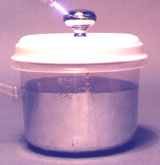
A 1.6 pint container
|

Frosting can.
|
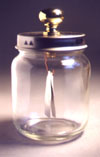
This is an electroscope. In the presence of a static charge imbalance
the loosely hanging foil leaves repel each other.
|
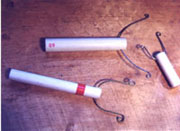
Discharge tongs
|
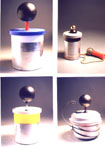
|
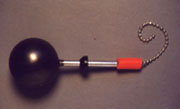
The electrode and stem from one of my Leyden jars.
|
Basic Anatomy
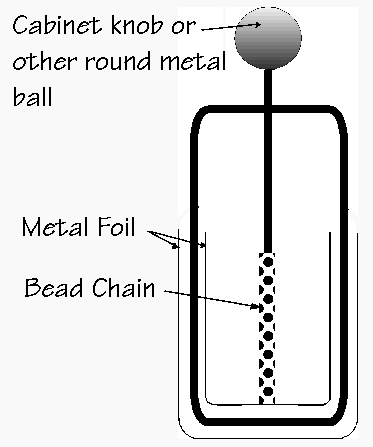
With some thought and research, excellent Leyden
jars can be made using common materials. For those who don't have the time
or resources to devote, there are people and companies
that sell Leyden jars or other electrostatic related equipment.
Something to keep in mind as you digest all of this
is that the length of spark an electrostatic machine can produce
is not directly dependent on the capacitance of the Leyden jar connected
to it. The
energy in the spark is directly related
to capacitance (and voltage). In other words, I'm saying that if you want
a longer spark you won't get it by just making a bigger Leyden jar. You'll
get a hotter, louder, more visible spark. Learn more about, and improve,
the design of your machine. I'm no genius when it comes to the laws
governing electricity, but there's one thing that I am positive about:
These
things get more dangerous as they get bigger. Once again, let
me say it another way: The pain a fully charged Leyden jar can inflict
varies directly with its capacitance. Small ones are almost like toys,
larger ones can leave you on your butt wondering what just happened. Don't
fool yourself into thinking that a couple of pieces of tin foil can't be
dangerous.
Don't just take my word for it, though, see what
Benjamin
Franklin had to say when he shocked the #$%^&#! out
of himself.
Other simple capacitors
More info about materials to
use for electrostatic experiments.
Back to the Static Generator
Page
